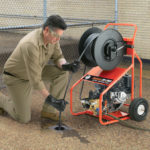Pipe Inspection and location systems represent a significant investment for most small businesses. In return, they offer unique diagnostic and marketing potential that can either save or earn a tremendous amount of money for your company. Choosing the right system for your needs is a task that should be taken with serious attention to detail in order to avoid a costly mistake. So, here are some points to ponder before shelling out your hard-earned cash:
- What size pipes/drains/sewers are you likely to be inspecting?
The great divide in pipe inspection systems is between push rod and tractor pull style systems. Which style do you need?
Tractor pull systems are generally for large, municipal style drain pipes (10 inch and larger) and pull themselves down the line. They tend to be controlled with a joystick and computer system by an operator sitting in a specially made truck or van. Prices begin in the high 30 thousands and go up from there. They are outfitted with additional lighting and swivel heads to look left, right, up and down. They are usually purchased by municipalities and larger companies.
Push rod style systems are designed for laterals and inside pipes. As the name implies, these systems are manually pushed down the line by the contractor. Range on these units is limited to 200 feet at the maximum. Line size is approximately 1 1/2 inch on the small end and 12 inch on the high end. Pipe size is limited by how far you can push, and amount of light necessary to get a usable picture. The market for push style units is much, much larger than for the tractor pull style units. Plumbers, drain cleaners, maintenance technicians, HVAC and electricians all tend to purchase push style camera systems. For that reason, we will focus on push style camera systems for the rest of the article.
There are three main sizes of push style camera systems:
Micro-systems, designed for 1 1/2 to 3-inch pipes. Due to the flexibility required for this size pipe, these push rods are very thin and weak. (Keep in mind that there is an inverse relationship between strength and flexibility.) If used in larger pipes, the probability of damage to the structure of the push rod is very high. They seldom have a built-in locator beacon, and may or may not have a built-in recording device.
Mini-systems, designed for 2 to 4-inch pipes. These systems are used for indoor work in the small and medium-sized pipes that connect bathrooms, sinks and toilets within a building. The push rod used in these units is stronger and less flexible than a micro unit, but the emphasis is still on flexibility, not strength. If used in larger pipes, these systems are at greater risk of kinking and damage. They usually have built-in locator beacons and often have the option of a built-in recording system.
Main line systems, designed for 3 to 12-inch lines. These systems are designed for use in outdoor pipes. While flexible enough to negotiate a house trap, the emphasis is on strength rather than flexibility. These systems generally have the same features as Mini-Systems.
The rule of thumb when purchasing a push system is that you want to use the largest, strongest push rod that will fit in the pipe. This will mitigate issues of wear and tear and allow you to push the camera head further down the line. The stronger the push rod, the further you can push it down the line.)When in doubt about whether to purchase a mini or a standard sized push rod, buy the standard.
- Do you need a built-in recording device?
Do you need to provide proof of performance? If so, having a built-in recording device can save you time and money.
Do you want to use the camera system as a marketing tool in addition to being a diagnostic tool? Is your primary focus the drain cleaning job, or are you actually in the pipe replacement/relining business? If you only need to take a ‘look-see,’ you don’t need a built-in recording device. For those rare instances when you need a recording, there are add-on recording devices available from most electronic retailers that are more economical and will work with any video device.
If you need a built-in recording device, the options at this point are DVD, SD card and USP-memory stick. (Rule of thumb, the less moving parts there are, the less likely to experience repair issues.) In addition, WiFi units are now available. This wireless feature easily allows contractors to use their iPads, Android tablets or smartphones to display the video output from camera systems. Utilizing these devices, contractors can save and upload video files to YouTube, social media or other networks in order to streamline and simplify the process of data sharing with customers.
- Do you need to be able to locate the camera head?
Most mini and standard sized units have built-in locator beacon so that you can pinpoint the location and depth of the camera head while it is in the pipe. Do not underestimate the importance of location in the inspection process. If in question, err on the side of safety and get the locator! While most locators are fairly accurate at this point, some are easier to use than others. Try them and see.
- How available is service after the sale?
Pipe inspection and location systems are video cameras that you shove down a sewer. What could possibly go wrong with that? Well, as it turns out, plenty! The bad news is that repairs to your camera system can be costly and lengthy.
The good news is that proper training can significantly reduce your repair bills! We have found that there is a very positive correlation between user technique and frequency of damage to camera units. This correlation cuts across all sizes and makes of inspection systems. For this reason, it’s wise to purchase your pipe inspection unit from a factory representative who can train you and your employees in the proper use of this high-tech product. Initial training can make the difference between profit and loss when it comes to camera systems.
Another aspect of service after the sale is the availability of repair centers. If and when the unit does need the care of a factory-trained repair center, it’s good to have one in your time zone. If your unit must be shipped back to mainland China for repair, it might be time to rethink your buying strategy.
These four questions will help to frame the search for your new pipe inspection system. Your familiarity and comfort with certain brands, dealers and representatives will also play a key role in your decision. Talk to friends and competitors for other points of view in order to gain insight into how these units perform in real life situations. The purchase of a camera system is a large investment that will impact the way your company does business for years to come. Take your time and make the right call!
Contact the Drain Brains® at General at 800-245-6200 or by email [email protected].



